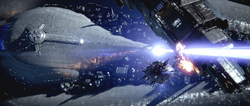Plasma: Difference between revisions
From Halopedia, the Halo wiki
mNo edit summary |
m (→Weaponry) Tag: Mobile edit |
||
| (67 intermediate revisions by 41 users not shown) | |||
| Line 1: | Line 1: | ||
{{ | {{Status|Canon}} | ||
{{Wikipedia|Plasma (physics)}} | |||
{{ | |||
| | |||
}} | |||
[[File:Halo3 E3 TRAILER 2007 720p30 ST 6300Kbps 002 0001.jpg|thumb|300px|Plasma being discharged by Covenant [[Ket-pattern battlecruiser|cruisers']] [[Energy Projector]]s.]] | |||
In physics and chemistry, '''plasma''' describes any substance where there is an ionic charge separation. A plasma can be either a solid or a gas, or more rarely a liquid. Plasmas show a marked difference in electrical and thermal conductivity compared to non-plasmas. The type of plasma most often thought of is gas plasma with an exceptionally high mass fraction of charge carriers. The closer the fraction is to unity, the more pronounced is the plasmic behaviour and responses to electromagnetic fields. | |||
== | ==Description== | ||
Metals are an example of solid plasmas; they are plasmas because there exists within the metal delocalized charge-carrying electrons. It is this property of metals that allows them to be good electrical and thermal conductors. Table salt is also an example of a solid plasma, as it is an ionic solid; there exists a lattice of charge-carrying ions, although they are not delocalized. In order to replicate the properties of metals, table salt has to be molten for the charges to move freely. An example of a gas plasma is fire produced by a combustion reaction, where there is a large amount of transitional ionization occurring. Liquid and gas plasmas are highly responsive to electromagnetic fields due to the mobilization of charge carriers (electrons, cations, and anions). Generally, plasmas behave very much like their respective states of matter, except for the supplementary behavior associated with plasmas. | |||
== | ==Applications== | ||
===Weaponry=== | |||
{{Main|Plasma weaponry}} | |||
[[File:Fight on Ascendant Justice.png|thumb|250px|[[John-117]] using a {{Pattern|Okarda'phaa|plasma rifle}} - one of the most common Covenant infantry weapons.]] | |||
[[Covenant]] [[Covenant military|military]] forces and the various factions that have branched off from the hegemony use plasma in weapons to great effect. These weapons contain and guide the plasma in the form of a single bolt, beam, or continuous stream. Plasma-based weapons are the most common armament of Covenant infantry and vehicular forces, and the main armament of their warships, dominating almost their entire weapon arsenal. Small arms are designed to deplete [[energy shielding]] or melt infantry armor, while heavier weapons can destroy vehicles or buildings. The largest are mounted onto [[capital ship]]s and are used for [[glassing|orbital bombardment]] and ship-to-ship combat, and can reduce a ship's hull to a pile of molten metal floating in space. When a plasma weapon is charging, a high quantity of beta particle radiation is emitted.<ref>'''[[Halo: The Fall of Reach]]''', ''page 147''</ref> | |||
[[ | The [[United Nations Space Command]] has yet to develop its own plasma weaponry, using more conventional projectile-based weapon systems. However, the UNSC has been seen to operate captured Covenant plasma weapons, and in one case, UNSC forces were able to dramatically improve the lethality of a [[Ascendant Justice|captured Covenant starship]]'s [[plasma torpedo]]es without significant technical modifications.<ref>'''[[Halo: First Strike]]''', ''page 177''</ref> There was an attempt to produce a [[M145D Rhino|tank]] with plasma-based weaponry for the [[United Nations Space Command]] armed forces, but it was abandoned, falling back on projectile weaponry.<ref>'''[[Halo Wars]]'''</ref> Some UNSC space-borne [[nuclear weapon]]s developed during the [[Human-Covenant War]] use a crude form of plasma weapon known as a Spear or Casaba Howitzer, in which the warhead's nuclear blast is directed into a focused plasma stream to better penetrate Covenant warship shielding.<ref>''[[Halo: Warfleet]]'', p. 92</ref> | ||
Complete armor protection from plasma weaponry is generally difficult to accomplish due to plasma's high damage ratio. The [[M52B body armor|armor]] used by the [[UNSC Marine Corps]] and [[UNSC Army]] usually provides good protection from plasma, but only to a certain extent. A series of hits from a plasma weapon will literally melt or burn the armor, rendering it useless. The [[SPARTAN-II]] [[MJOLNIR Armor|armor]] variant is similar to the Marines' armor, in that it will eventually give way to the plasma. Most newer versions of the Spartans' armor boast [[Energy shielding#Human energy shielding|energy shields]], which provide additional protection from plasma, although shielding systems can be completely depleted by sustained plasma fire, or a single, overcharged bolt. | |||
[[File:H2A Cutscene EnergyProjectorPiercing.png|thumb|250px|A {{Class|CAS|assault carrier}}'s [[energy projector]] piercing the hull of a {{Class|Marathon|heavy cruiser}}.]] | |||
The armor of neither Covenant nor UNSC warships provides significant protection against plasma, which will melt through the hulls of both. [[Titanium]], a key component of UNSC ship armor, has a melting point of 1668 degrees Celsius.{{Ref/Note|There is a difference between baseline titanium and [[Titanium-A armor|Titanium-A]], an augmented form of titanium, used in UNSC starship armor. This along with the fact that Titanium-A armor is sometimes layered with [[tungsten]] (which has a melting point of 3,422 °C) means that the melting point of their starship armor is higher than that of conventional titanium.}} In all encounters with Covenant ships, plasma-based weaponry has melted through and disabled UNSC ships in a matter of seconds. However, it is possible that since the UNSC uses [[Titanium-A armor|Titanium-A]], an augmented form of titanium, in its ship armor, the melting point of their starship armor is much higher than suspected. | |||
===Other uses=== | |||
The [[fusion reactor]]s used by the UNSC produce plasma via [[nuclear fusion]]; the Covenant use a comparable type of power plant known as the [[pinch fusion reactor]]. Plasma also has various industrial uses, such as cutting heavy metals in factories. | |||
==Trivia== | |||
*For gameplay reasons, plasma is less lethal to unshielded [[Non-playable character|NPC]]s in the [[Halo universe|''Halo'' games]] than in the novels. In the games, Marines can take a barrage from a plasma weapon without being incapacitated, but in the books there are several instances of plasma easily burning through both armor and flesh. This disparity is due to gameplay mechanics, rather than being a canon contradiction. | |||
*[[Frank O'Connor]], during his tenure as [[Bungie]]'s head of public relations, stated that the plasma used by the Covenant is not plasma as current science knows it, but something "far more dangerous, arcane, and destructive."<ref>[http://forums.bungie.org/halo/archive25.pl?read=743326 '''halo.bungie.org''': ''Re: Could Covenant Plasma weapons be disrupted?'']</ref> This has not been elaborated on in later sources and some actually indicate otherwise, with ''[[Halo 4: The Essential Visual Guide]]'' specifically making a note that the Covenant used conventional plasma in imitation of Forerunner particle weaponry.<ref>'''[[Halo 4: The Essential Visual Guide]]''', ''page 103''</ref> | |||
==Notes== | |||
{{Ref/Notes}} | |||
==Sources== | ==Sources== | ||
{{Ref/Sources}} | |||
[[Category:Physics]] | |||
[[Category: | |||
Latest revision as of 20:25, November 8, 2023
| There is more information available on this subject at Plasma on the English Wikipedia. |
In physics and chemistry, plasma describes any substance where there is an ionic charge separation. A plasma can be either a solid or a gas, or more rarely a liquid. Plasmas show a marked difference in electrical and thermal conductivity compared to non-plasmas. The type of plasma most often thought of is gas plasma with an exceptionally high mass fraction of charge carriers. The closer the fraction is to unity, the more pronounced is the plasmic behaviour and responses to electromagnetic fields.
Description[edit]
Metals are an example of solid plasmas; they are plasmas because there exists within the metal delocalized charge-carrying electrons. It is this property of metals that allows them to be good electrical and thermal conductors. Table salt is also an example of a solid plasma, as it is an ionic solid; there exists a lattice of charge-carrying ions, although they are not delocalized. In order to replicate the properties of metals, table salt has to be molten for the charges to move freely. An example of a gas plasma is fire produced by a combustion reaction, where there is a large amount of transitional ionization occurring. Liquid and gas plasmas are highly responsive to electromagnetic fields due to the mobilization of charge carriers (electrons, cations, and anions). Generally, plasmas behave very much like their respective states of matter, except for the supplementary behavior associated with plasmas.
Applications[edit]
Weaponry[edit]
- Main article: Plasma weaponry

Covenant military forces and the various factions that have branched off from the hegemony use plasma in weapons to great effect. These weapons contain and guide the plasma in the form of a single bolt, beam, or continuous stream. Plasma-based weapons are the most common armament of Covenant infantry and vehicular forces, and the main armament of their warships, dominating almost their entire weapon arsenal. Small arms are designed to deplete energy shielding or melt infantry armor, while heavier weapons can destroy vehicles or buildings. The largest are mounted onto capital ships and are used for orbital bombardment and ship-to-ship combat, and can reduce a ship's hull to a pile of molten metal floating in space. When a plasma weapon is charging, a high quantity of beta particle radiation is emitted.[1]
The United Nations Space Command has yet to develop its own plasma weaponry, using more conventional projectile-based weapon systems. However, the UNSC has been seen to operate captured Covenant plasma weapons, and in one case, UNSC forces were able to dramatically improve the lethality of a captured Covenant starship's plasma torpedoes without significant technical modifications.[2] There was an attempt to produce a tank with plasma-based weaponry for the United Nations Space Command armed forces, but it was abandoned, falling back on projectile weaponry.[3] Some UNSC space-borne nuclear weapons developed during the Human-Covenant War use a crude form of plasma weapon known as a Spear or Casaba Howitzer, in which the warhead's nuclear blast is directed into a focused plasma stream to better penetrate Covenant warship shielding.[4]
Complete armor protection from plasma weaponry is generally difficult to accomplish due to plasma's high damage ratio. The armor used by the UNSC Marine Corps and UNSC Army usually provides good protection from plasma, but only to a certain extent. A series of hits from a plasma weapon will literally melt or burn the armor, rendering it useless. The SPARTAN-II armor variant is similar to the Marines' armor, in that it will eventually give way to the plasma. Most newer versions of the Spartans' armor boast energy shields, which provide additional protection from plasma, although shielding systems can be completely depleted by sustained plasma fire, or a single, overcharged bolt.
The armor of neither Covenant nor UNSC warships provides significant protection against plasma, which will melt through the hulls of both. Titanium, a key component of UNSC ship armor, has a melting point of 1668 degrees Celsius.[Note 1] In all encounters with Covenant ships, plasma-based weaponry has melted through and disabled UNSC ships in a matter of seconds. However, it is possible that since the UNSC uses Titanium-A, an augmented form of titanium, in its ship armor, the melting point of their starship armor is much higher than suspected.
Other uses[edit]
The fusion reactors used by the UNSC produce plasma via nuclear fusion; the Covenant use a comparable type of power plant known as the pinch fusion reactor. Plasma also has various industrial uses, such as cutting heavy metals in factories.
Trivia[edit]
- For gameplay reasons, plasma is less lethal to unshielded NPCs in the Halo games than in the novels. In the games, Marines can take a barrage from a plasma weapon without being incapacitated, but in the books there are several instances of plasma easily burning through both armor and flesh. This disparity is due to gameplay mechanics, rather than being a canon contradiction.
- Frank O'Connor, during his tenure as Bungie's head of public relations, stated that the plasma used by the Covenant is not plasma as current science knows it, but something "far more dangerous, arcane, and destructive."[5] This has not been elaborated on in later sources and some actually indicate otherwise, with Halo 4: The Essential Visual Guide specifically making a note that the Covenant used conventional plasma in imitation of Forerunner particle weaponry.[6]
Notes[edit]
- ^ There is a difference between baseline titanium and Titanium-A, an augmented form of titanium, used in UNSC starship armor. This along with the fact that Titanium-A armor is sometimes layered with tungsten (which has a melting point of 3,422 °C) means that the melting point of their starship armor is higher than that of conventional titanium.
Sources[edit]
- ^ Halo: The Fall of Reach, page 147
- ^ Halo: First Strike, page 177
- ^ Halo Wars
- ^ Halo: Warfleet, p. 92
- ^ halo.bungie.org: Re: Could Covenant Plasma weapons be disrupted?
- ^ Halo 4: The Essential Visual Guide, page 103

